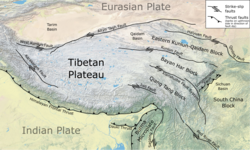1850 Xichang earthquake
| Local date | September 12, 1850 |
|---|---|
| Magnitude | Mw 7.6–7.9 [1] Ms 7.7 |
| Epicenter | 27°48′N 102°18′E / 27.8°N 102.3°E [2] |
| Areas affected | Qing dynasty |
| Max. intensity | MMI XI (Extreme) [3] |
| Casualties | 20,650+ dead |
The 1850 Xichang earthquake rocked
Tectonic setting

Earthquake
The earthquake occurred as a result of left-lateral
Characteristics
The earthquake rupture attracted the attention of seismologists because the Anninghe and Zemuhe faults ruptured during the same event; where a restraining bend could not stop the rupture propagation. Restraining bends or zones of transpression have been previously thought to arrest or cease an earthquake rupture. The restraining bend measuring 30° displayed extensional tectonics was not effective and failed to arrest the rupture.[1]
A maximum coseismic slip of 5–6 meters was measured along a preserved
Rupture on the southern section of the Anninghe Fault also resulted in a zone of high-intensity shaking assigned VII–VIII. The surface offsets on the Anninghe Fault are much smaller, ranging from 1–1.5 meters. Based on the historical documentation of the event and its associated surface ruptures, the total ruptured length on both faults is at least 150 km. A
Impact
In
A massive ground fissure measuring 33 meters long, 10 meters wide, and 17 meters deep opened in the city ground. Trees were uprooted and toppled while roads cracked. Several large landslides occurred near Qiong Lake. Ground failures and fissuring led to water erupting out of the ground. Major liquefaction events such as the ejection of water and sand occurred at Beishan Mountains, Qiong Lake and the Anning River. Villages along the banks of Qiong Lake were flooded.[2]
Legacy
The destruction left by the quake was the third to seriously affect Xichang. The earthquakes in 1536 and 1732 also caused great devastation, killing thousands. The Xichang Earthquake Forest near Xichang serves as a location to remember the victims of the earthquakes. The events were documented and
See also
References
- ^ .
- ^ a b c "Significant Earthquake Information". ngdc.noaa.gov. NOAA National Centers for Environmental Information. Retrieved 18 October 2021.
- ^ doi:10.4401/ag-3444.
- S2CID 134590278.
- .
- ^ .
- ^ Wu Xiaoling (3 April 2020). "200余通石碑 刻下西昌500年地震记忆" [More than 200 stone steles inscribe the memory of the 500-year earthquake in Xichang] (in Chinese). People's Daily. Retrieved 18 October 2021.



